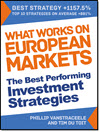If you want to find the best investments early - and avoid the ones that disappoint - this post is for you. You will learn why Return on Invested Capital (ROIC) is one of the most powerful ratios in stock investing. It shows how efficiently a company turns capital into profits and why high-ROIC companies outperform over time.
You will also learn how to compare ROIC to other ratios like ROA and ROE, how to use it in a stock screener, and what hidden risks to watch for. Mastering ROIC can change how you invest.
Estimated Reading time: 6 minutes
What Is ROIC and Why It Matters
If you want to buy great companies, you should care about Return on Invested Capital, or ROIC. It is important because ROIC tells you how well a business uses profits to make more money.
We calculate ROIC like this:
ROIC = Trailing 12-Month EBIT / ((Current Assets – Current Liabilities) + Net Fixed Assets)
This formula helps you focus only on the money a company earns on the working assets it needs to earn those returns. This way, you get a true sense of how efficient the business really is.
Why does that matter?
Because high ROIC often means the company is very profitable. This means it is doing something right. For example, it has loyal customers, less need for new factories or does not need a lot of assets, and better pricing power.
These are the companies that often grow quietly and beat the market over time. If you want to spot winners early, ROIC gives you a big clue.
ROIC, ROA and ROE Comparison
Here is a quick comparison of some of the quality ratios available in the Quant Investing stock screener. Make a note of how they are calculated to best use them in your investment strategy.
- Return on Invested Capital (ROIC) = Trailing 12-month EBIT / ((Current assets – Current liabilities) + Net Fixed Assets)
- Return on Assets (ROA) = Trailing 12-month Net income after tax / Total assets
- Return on Equity (ROE) = Trailing 12-month Net profit after tax / Common shareholders’ equity
You will see ROIC stands out because it uses operating profit (EBIT) over operating assets which is a powerful way to evaluate the quality of a company.
Click here to start using the ROIC in your stock screens NOW! - Click here
ROIC: The Hidden Power in Quant Strategies
You might have heard of value investing or momentum investing. These are popular “factors” or investment strategies that help explain why some stocks beat others. But not many investors look at ROIC as a factor.
That is a missed opportunity.
Joel Greenblatt, the great hedge fund manager, made ROIC famous with his Magic Formula. His idea was simple: buy cheap companies that are also very profitable. He used Earnings Yield (EBIT to EV) for valuation and ROIC for quality. And it worked. Over many years, the strategy beat the market by a wide margin.
If you want to copy that success, ROIC is a smart tool to start using. It helps you avoid low-quality value traps - companies that look cheap but are cheap for a reason.
Magic Formula Backtests
You can see all the back tests of the Magic Formula we could find here: All the Back Tests of the Magic Formula Summarised.
Three Things Most Investors Miss About ROIC
Be Careful with Super-High ROIC
Not all high ROIC businesses are worth buying. Some, like consulting firms or ad agencies, need almost no capital. This gives them huge ROIC numbers. But these businesses are built on people, not systems or brands. If the people leave, the value disappears.
Unless the company has a strong reason to exist or has a strong moat, like Moody’s, as a regulated entity it might not be a great investment.
Be careful when you see ROICs over 50%. Take a closer look at the business.
ROIC Means Less if the Company Cannot Grow
Even Warren Buffett hit this wall. His candy company, See’s Candies, earned great returns but could not grow much. That meant he could not reinvest profits into the same business. He had to find new places to invest.
For you, that is a risk too. If you buy a great ROIC business that cannot grow, your returns will flatten over time. The real dream is finding companies that earn high ROIC and can reinvest those profits at the same high returns.
ROIC Can Help You During Inflation
Inflation is sneaky and destroys the value of money over time. It makes everything more expensive, especially the machines, materials, and staff that companies need to grow. If a company must spend a lot to grow, inflation eats into profits.
But high-ROIC businesses often need very little extra investment. They can grow earnings without buying or building new factories or holding huge inventories. That makes them better positioned when prices rise.
If you think inflation might return then focusing on capital-light, in other words high-ROIC businesses is a smart decision.
How You Can Use ROIC in Your Screener Today
You do not have to build your own formulas or read 100-page reports. Tools like the Quant Investing Stock Screener already let you filter for ROIC, value, growth, and even reinvestment potential.
Here is a simple 4-step high ROIC screen you can run:
-
ROIC > 15%
-
Free Cash Flow Yield > 10%
-
5-Year Sales Growth > 5%
-
Earnings Yield (EBIT/EV) in top 20%
This gives you a list of growing strong, profitable businesses that are also attractively priced.
Click here to start using the ROIC in your stock screens NOW! - Click here
Why Most Investors Ignore ROIC (and Why That Helps You)
ROIC is not flashy. It does not trend on social media or pop up in earnings headlines.
That is good news for you.
Most investors chase excitement. They want stories, not numbers. They ignore ROIC because it takes more thought and is not available everywhere.
But that edge is yours for the taking. Using ROIC to select investment ideas makes you calmer during market drops. When others panic, you know your companies are efficient, well-run, and less likely to blow up.
That, along with a good loss limiting strategy, gives you the confidence to hold through storms, and that is where real returns come from.
Your Next Step: Make ROIC a Daily Habit
Start using ROIC every time you research a stock.
Add it to your screens. If ROIC is low, ask why. If it is high, check if the company can grow and reinvest. Use your screener to filter the noise and focus only on high-quality businesses.
ROIC will not give you excitement. But it will give you results, if you stay patient. Let it guide your thinking, and you will avoid most traps other investors walk into.
Click here to start using the ROIC in your stock screens NOW! - Click here
FREQUENTLY ASKED QUESTIONS
1. Why should I care about ROIC instead of just looking at earnings or stock price?
Because ROIC shows how efficiently a company turns its operating assets into more money. It tells you if the business is good at growing without needing to spend a lot. Unlike earnings, ROIC reveals quality. Great businesses often have high ROIC, which can lead to strong long-term returns.
2. How can I tell if a company’s ROIC is “high enough”?
A ROIC above 15% is a solid signal. But do not stop there. Ask: Can the company keep growing and reinvest at that high rate? A one-time spike does not mean it is a great business. Check if it has kept ROIC high for years. That shows real strength.
3. What if a company has a super high ROIC, like over 50%? Should I jump in?
Be careful. Some companies, like consulting firms, have high ROIC because they do not need much capital. But that also means they can lose value fast if key people leave. Unless the company has a moat - like a brand, license, or market power, avoid chasing extreme ROIC numbers.
4. Can a company with great ROIC still be a bad investment?
Yes. If it cannot grow, its high ROIC becomes less useful. Warren Buffett saw this with See’s Candies. The company earned great returns but could not reinvest them. Look for high-ROIC companies that can also grow. That is where long-term compounding happens.
5. How does ROIC help during inflation?
High-ROIC companies often do not need to spend a lot to grow. That is powerful during inflation, when costs go up. These businesses can keep earning more without building new factories or holding big inventories. That means more profit even when prices rise.
6. I use a screener. What is an easy way to add ROIC into my process?
Use this simple 4-step filter in your screener:
-
ROIC > 15%
-
Free Cash Flow Yield > 10%
-
5-Year Sales Growth > 5%
-
Earnings Yield in top 20%
This helps you find strong, growing, and well-priced companies quickly.
7. Why do most investors ignore ROIC if it is so important?
Because it takes more thought. Most investors chase headlines or hot tips. ROIC is quiet. It does not trend. But that is your edge. While others react, you can focus on the numbers that matter. ROIC helps you stay calm and confident, even when markets drop.
Click here to start using the ROIC in your stock screens NOW! - Click here


